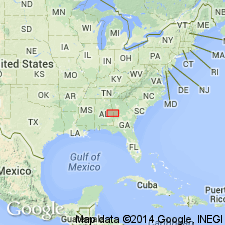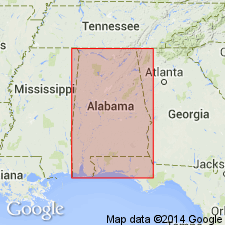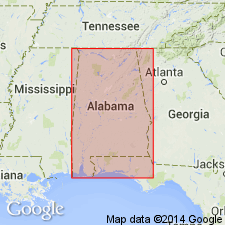
- Usage in publication:
-
- Kowaliga Gneiss
- Modifications:
-
- Named
- Dominant lithology:
-
- Gneiss
- AAPG geologic province:
-
- Piedmont-Blue Ridge province
Summary:
Name Kowaliga Gneiss proposed for a large mass of coarse-grained quartz-monzonite gneiss that intrudes Centralhatchee Formation of Heard Group in Elmore Co., central AL. Main body of the Kowaliga covers an extensive area of Elmore Co. In Tallapoosa Co. the unit becomes elongated, narrow, and finally pinches out to the northeast near Zana. Characterized by a complex assemblage of augen gneisses with both orthoclase and plagioclase augen. Major part of Kowaliga is a quartz monzonite containing plagioclase, microcline, quartz, biotite, and epidote. Age is early Paleozoic.
Source: GNU records (USGS DDS-6; Reston GNULEX).

- Usage in publication:
-
- Kowaliga augen gneiss
- Modifications:
-
- Reference
- AAPG geologic province:
-
- Piedmont-Blue Ridge province
Summary:
Kowaliga mapped for up to 65 km along strike. Type localities proposed in two quarries near Kowaliga Creek arm of Lake Marten (sec. 24, T20N, R20E, and sec. 2, T20N, R21E) where unit is gray, plagioclase-biotite gneiss with quartz-feldspar layers 8 mm thick separated by biotite-rich layers 1-2 mm thick. Unit is not as large as previously thought. It is here restricted by mineralogical criteria: abundant plagioclase and biotite, very little muscovite.
Source: GNU records (USGS DDS-6; Reston GNULEX).

- Usage in publication:
-
- Kowaliga Gneiss
- Modifications:
-
- Geochronologic dating
- AAPG geologic province:
-
- Piedmont-Blue Ridge province
Summary:
Ordovician ages have been determined for the Kowaliga Gneiss (460+/-19 Ma) and the Elkahatchee Quartz Diorite (490+/-28 Ma). U-Pb zircon and Rb-Sr whole-rock analyses indicate Kowaliga and Zana Granite both formed 460 m.y. ago but are either from separate magmas or the Zana is contaminated by country rock.
Source: GNU records (USGS DDS-6; Reston GNULEX).

- Usage in publication:
-
- Kowaliga Gneiss
- Modifications:
-
- Overview
- AAPG geologic province:
-
- Piedmont-Blue Ridge province
Summary:
Kowaliga Gneiss is a gray coarse-grained granodiorite to quartz and plagioclase-biotite gneiss, monzonite, with plagioclase or microcline augen up to 4 in. in diameter. Generally sheared along margins. Age is Ordovician.
Source: GNU records (USGS DDS-6; Reston GNULEX).
For more information, please contact Nancy Stamm, Geologic Names Committee Secretary.
Asterisk (*) indicates published by U.S. Geological Survey authors.
"No current usage" (†) implies that a name has been abandoned or has fallen into disuse. Former usage and, if known, replacement name given in parentheses ( ).
Slash (/) indicates name conflicts with nomenclatural guidelines (CSN, 1933; ACSN, 1961, 1970; NACSN, 1983, 2005, 2021). May be explained within brackets ([ ]).

